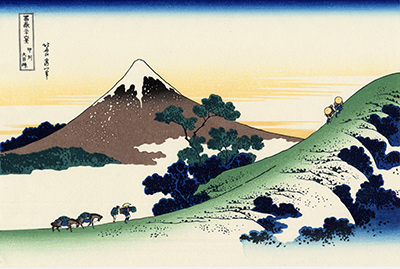The Inume Pass in Kai Province or Kōshū Inume tōge), is one of the masterpieces of Katsushika Hokusai’s series Thirty-six Views of Mount Fuji also called Fugaku sanjūrokkei. Hokusai was born in 1760 in Edo District in Japan during the Edo period and died in 1849.
The print Inuma Pass in Kai Province was printed in ca. 1830-32 during the Edo period of between 1615 and 1868. The print was produced on a Polychrome woodblock print; ink and color on paper with dimensions of 9 7/8 x 14 7/8 in. (25.1 x 37.8 cm), and classified as a print. The print represents the post-town on the pass along the Koshu Highway, between today’s Uenohara-shi and Otsuki-shi Yamanashi prefecture. The Ukiyo-e artwork print depicts travellers walking along Mount Fuji’s light vegetation during early summer.
The unique relationship between humans and the environment is artistically portrayed as small persons walk the hill as the massive Mount Fuji is seemingly towering over them. The clouds printed behind the travellers shows that there is a distance between people and the huge Mount Fuji. The impressive woodblock artwork produces an atmosphere where time and breeze seem to flow in a slow motion. Since he started painting at a tender age, together with his father Nakajima Ise who was a mirror-maker, Hokusai believed that if he could have lived to the age of 140 years-old, his brush strokes could have had the magic to bring his images to life.
Around 1834 in his later years of his career, Hokusai adopted the name Gakyō Rōjin Manji, which literally means The Old Man Mad About Art. It was at this point that he came up with the idea of producing One Hundred Views of Mount Fuji, which were basically a series of interesting landscapes. Disaster struck his career in 1839 when a fire razed down his artwork studio and paved the way for younger artists of that time like Andō Hiroshige who became very popular. But since he was so engrossed into art, he produced Ducks in a Stream at the age of 87. Although he felt that he could still do better than what he had done, he died in his bed and was buried in Seikyō-ji in Tokyo (Taito Ward).




